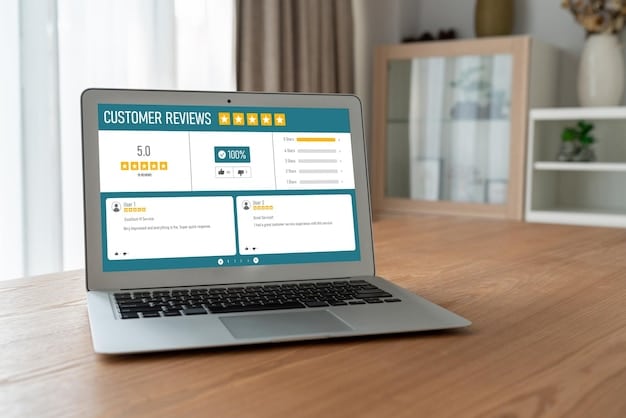E-commerce SEO in 2025: Dominate Google Rankings

E-commerce Search Engine Optimization: Ranking Higher in Google for Increased Traffic in 2025 requires adapting to evolving algorithms. Strategies include mobile-first indexing, voice search optimization, and leveraging AI for personalized experiences to enhance online visibility and drive conversions.
In the ever-evolving landscape of e-commerce, staying ahead means adapting your strategies to meet the demands of search engine algorithms. Are you prepared to leverage the latest techniques in E-commerce Search Engine Optimization: Ranking Higher in Google for Increased Traffic in 2025?
This guide will delve into actionable strategies that can help businesses like yours to not only rank higher, but also attract more relevant traffic and ultimately, boost sales. Let’s explore the future of e-commerce SEO together!
Understanding the Evolving Landscape of E-commerce SEO
Search engine optimization (SEO) for e-commerce is not a static practice. It’s a dynamic field influenced by algorithm updates, changing user behavior, and emerging technologies. To achieve E-commerce Search Engine Optimization: Ranking Higher in Google for Increased Traffic in 2025, understanding these changes is crucial.
The Shift Towards Mobile-First Indexing
Google’s mobile-first indexing prioritizes the mobile version of a website for ranking. This means your e-commerce site must deliver an exceptional mobile experience. Focus on responsive designs, fast loading speeds, and intuitive navigation for mobile users.
The Importance of User Experience (UX)
UX is now a major ranking factor. Google prioritizes websites that offer a seamless and enjoyable experience. Optimize your site for speed, ease of navigation, and clear calls to action. A positive user experience translates to higher engagement and better rankings.
- Ensure your website is mobile-friendly.
- Optimize page loading speed.
- Implement clear and intuitive navigation.
- Use high-quality product images and descriptions.
In conclusion, staying informed about the latest trends and algorithm updates is essential. Embrace mobile optimization, prioritize user experience, and stay adaptable to future changes. This forward-thinking approach is crucial for sustained success in the competitive e-commerce landscape. This proactive stance will significantly increase your chances of achieving E-commerce Search Engine Optimization: Ranking Higher in Google for Increased Traffic in 2025.
Keyword Research for E-commerce in 2025
Keyword research remains the cornerstone of successful SEO. However, the approach to keyword research is evolving. In 2025, it’s about understanding user intent and identifying long-tail keywords that reflect natural language search queries.
Leveraging Long-Tail Keywords
Long-tail keywords are longer, more specific phrases that users type into search engines. They often reflect a higher level of intent and can attract more qualified traffic. Focus on creating content that answers specific questions and addresses niche interests.
Analyzing Competitor Keywords
Analyzing your competitors keywords can reveal valuable insights. Identify the keywords they are ranking for and the content they are creating. Use this information to refine your own keyword strategy and identify opportunities where you can outrank them.

- Use keyword research tools to identify relevant long-tail keywords.
- Analyze competitor keyword strategies.
- Focus on user intent when selecting keywords.
- Update your keyword strategy regularly based on performance data.
To sum up, effective keyword research in 2025 requires a focus on user intent, long-tail keywords, and continuous analysis. By adapting your keyword strategy to reflect these changes, you can attract more qualified traffic and improve your chances of E-commerce Search Engine Optimization: Ranking Higher in Google for Increased Traffic in 2025. Embracing this data-driven approach is crucial for staying competitive.
On-Page Optimization Techniques for E-commerce
On-page optimization involves optimizing elements within your website to improve search engine rankings and user experience. This includes optimizing title tags, meta descriptions, header tags, and content.
Optimizing Title Tags and Meta Descriptions
Title tags and meta descriptions are crucial for attracting clicks from search engine results pages (SERPs). Write compelling and accurate title tags and meta descriptions that include relevant keywords and highlight the unique value proposition of your products.
Improving Website Structure and Navigation
A well-structured website is easier for search engines to crawl and understand. Use clear and consistent navigation, internal linking, and XML sitemaps to improve website structure and enhance SEO. A logical and user-friendly structure helps search engines index your site effectively.
Optimizing images involves compressing them for faster loading speeds, using descriptive file names, and adding alt text. Image optimization not only improves website performance but also provides search engines with valuable context about your products.
In conclusion, effective on-page optimization in 2025 requires a comprehensive approach. Focus on optimizing title tags, meta descriptions, website structure, and images. By implementing these techniques, you can improve search engine rankings, enhance user experience, and achieve significant gains in E-commerce Search Engine Optimization: Ranking Higher in Google for Increased Traffic in 2025. A well-optimized website is essential for success.
Content Marketing Strategies for E-commerce SEO
Content marketing is a powerful tool for attracting and engaging your target audience. By creating valuable and informative content, you can establish your e-commerce business as an authority in your industry and improve your visibility in search engine results.
Creating High-Quality Product Descriptions
Product descriptions are more than just a list of features. They should tell a story, highlight the benefits of your products, and address the needs and pain points of your target audience. High-quality product descriptions can significantly improve conversion rates.
Blogging for E-commerce SEO
Blogging is an effective way to attract organic traffic and establish your expertise. Write blog posts that address common questions, provide helpful tips, and share insights related to your industry. This can drive traffic and help with E-commerce Search Engine Optimization: Ranking Higher in Google for Increased Traffic in 2025.

- Create high-quality product descriptions that highlight benefits.
- Write informative and engaging blog posts.
- Use video marketing to showcase your products.
- Engage with your audience on social media.
In conclusion, effective content marketing is about creating value for your audience. Focus on high-quality product descriptions, informative blog posts, engaging videos, and active social media engagement. By implementing these strategies, you can attract more organic traffic, improve conversion rates, and achieve substantial improvements in E-commerce Search Engine Optimization: Ranking Higher in Google for Increased Traffic in 2025. Consistent, valuable content is key to long-term success.
Technical SEO for E-commerce: Ensuring a Smooth User Experience
Technical SEO focuses on optimizing the technical aspects of your website to improve search engine crawling and indexing. This includes ensuring your site is mobile-friendly, fast-loading, and secure.
Improving Website Speed and Performance
Website speed is a critical factor for both user experience and SEO. Optimize your images, leverage browser caching, and use a content delivery network (CDN) to improve website speed and performance. A faster website leads to higher engagement and better rankings.
Ensuring Mobile-Friendliness and Responsiveness
With the majority of online shoppers using mobile devices, ensuring your website is mobile-friendly is essential. Use a responsive design that adapts to different screen sizes, and test your site on various devices to ensure a seamless mobile experience.
Security is a top priority for both users and search engines. Obtain an SSL certificate to secure your website and protect sensitive data. A secure website builds trust and improves search engine rankings.
In conclusion, technical SEO is vital for providing a seamless user experience and improving search engine visibility. Focus on website speed, mobile-friendliness, and security. By optimizing these technical aspects, you can enhance user engagement, improve search engine rankings, and drive more traffic to your e-commerce site. This ensures you are on the right path for E-commerce Search Engine Optimization: Ranking Higher in Google for Increased Traffic in 2025.
Leveraging AI and Machine Learning in E-commerce SEO
AI and machine learning are transforming the SEO landscape. By leveraging these technologies, you can personalize the user experience, automate tasks, and gain valuable insights into customer behavior.
Personalizing the User Experience with AI
AI can analyze user data to personalize product recommendations, search results, and content. By tailoring the experience to individual preferences, you can increase engagement and conversion rates. Personalized experiences create a more satisfying shopping journey.
Automating SEO Tasks with Machine Learning
Machine learning can automate various SEO tasks, such as keyword research, content optimization, and link building. This can save time and resources, allowing you to focus on more strategic initiatives. Automation improves efficiency and effectiveness.
AI can analyze vast amounts of data to identify trends, patterns, and opportunities. Use AI-powered analytics tools to gain insights into customer behavior, keyword performance, and competitor strategies. Data-driven insights lead to better decision-making.
To conclude, AI and machine learning offer tremendous potential for enhancing e-commerce SEO. Embrace these technologies to personalize the user experience, automate tasks, and gain valuable insights. By leveraging AI and machine learning, you can stay ahead of the competition, improve search engine rankings, and drive significant growth. This innovative approach is key to achieving E-commerce Search Engine Optimization: Ranking Higher in Google for Increased Traffic in 2025.
| Key Element | Brief Description |
|---|---|
| 🚀 Mobile-First | Prioritize mobile experience for better rankings. |
| 🔎 Keyword Research | Focus on user intent and long-tail keywords. |
| 🤖 AI & Automation | Use AI for personalization and automating SEO tasks. |
| ⚡ Site Speed | Optimize website speed for better user experience. |
Frequently Asked Questions
To improve your mobile e-commerce site, ensure it has a responsive design, fast loading speeds, and easy navigation. Prioritize mobile user experience to increase engagement and conversions.
Long-tail keywords are specific phrases that users search for. Use them by creating content that directly answers niche queries, improving your chances of attracting targeted traffic.
AI enables personalization of user experiences, automates SEO tasks, and provides data-driven insights. Leveraging AI can lead to improved rankings and higher conversion rates.
Website speed is crucial because it affects user experience and search engine rankings. Faster websites lead to higher engagement rates, lower bounce rates, and improved visibility in search results.
Content is essential for attracting and engaging your target audience. High-quality product descriptions, blog posts, and videos can improve visibility in search results and establish authority.
Conclusion
As we look toward 2025, mastering E-commerce Search Engine Optimization: Ranking Higher in Google for Increased Traffic in 2025 is crucial for staying competitive. Embrace mobile-first indexing, leverage AI, and continuously optimize your content to meet the evolving demands of search engines and users alike.





